|
THE DRIVING GAMES BIBLE
The
history of driving games is an unusual one. Whereas most genres follow a
linear evolutionary path, becoming steadily more complex and more
technically impressive with time, driving games are different. Driving
games started in 3D and then went backwards to 2D for several years.
They started off quite technically realistic and demanding, then went
backwards and became more simplistic and easier. Graphics got prettier,
more colourful and more dramatic, then went backwards and became greyer
and duller, and so on. We needed someone intimately familiar with the
idea of going forwards then backwards to chart it all, so obviously we
called Stuart Campbell.
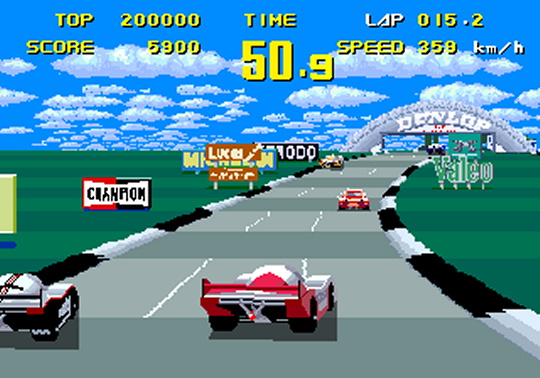
Konami’s 1986 coin-op WEC Le Mans, which isn’t mentioned anywhere in
this feature.
The first instance of driving a car in a
videogame was on Atari's 1976 classic Night Driver. A black screen
faced the player, decorated only with a series of short white posts
disappearing into the horizon to produce an eerily convincing
sensation of 3D. Speeding through the moonlit world at the kind of
game velocity the hardware could impart by, essentially, having no
graphics (even your car’s bonnet was just a plastic sticker attached
to the monitor), you couldn't afford to take your eyes off the
screen for a second.
Steering wheels were next seen in
videogame parlours on the Sprint series of overhead-viewed circuit
games, starting with Sprint 2 in 1976, confusingly followed by
Sprint 4 and Sprint 8 in 1977 and finally Sprint 1 in 1978. The
numbering doesn’t denote sequels - although the various games did
have different tracks - but the number of players. Sprint 8,
impressively, was therefore for eight players simultaneously, all
squished around one fairly normal-sized machine and making arcade
owners swoon with happiness.
To compensate for the lack of human
opposition, Sprint 1 does a remarkable and unique thing: the tracks
change while you’re driving. One minute you’re zooming round
a nice simple loop, then without warning the entire course switches
to a complex crossover route, and then a few seconds later morphs
again to a zig-zag collection of long straights, and so on. If
you’re not expecting it – and why would you be? – it’s hugely
startling and scary.
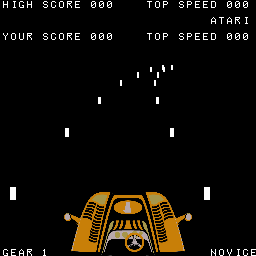
Night Driver - in fact, not even nearly the first driving
videogame. Fooled you! Ha ha!
Night Driver and Sprint both had purely
demarcative graphics – that is, wholly abstract lines and dots which
served only to mark the distinction between the traversable course
and the “walls” marking the limits of where you could go. The first
coin-op driving game to feature actual graphics in the sense we
understand the term today (that is, depicting some sort of actual
scenery) was Atari’s 1977 release Super Bug, which gave the player
an identifiable vehicle (a VW Beetle) some dense woodland to drive
through. Super Bug also saw the first introduction of “realistic”
handling – in addition to having to cope with manual switching
through four gears (something not seen in arcade games in the
following 30 years), your Bug is prone to drift, fishtailing like
crazy if you go round corners too fast. It’s an incredibly demanding
game which will leave the most dedicated modern racing fan weeping
in a corner within minutes.
Not satisfied with that, though, Atari
followed Super Bug up with the conceptually similar Fire Truck the
next year (which despite still being in greyscale also saw a
significant aesthetic improvement, with the graphics now depicting
an identifiable and rather attractive, albeit somewhat Lego-ey,
suburban landscape with houses, lawns, trees and parked cars).
Fire Truck was the first - so far the
only - co-op driving game, and saw two players charged with steering
a single fire engine through the scrolling overhead course, with one
of them driving the cab and the other trying to keep the trailer
under control. (There was a later single-player version called Smoky
Joe.) It’s absurdly difficult, and almost certainly the most
technical driving game ever created, making a mockery of Gran
Turismo fans and their fiddling with wheel balancing, brake
adjusting and grocket fondling. Only when you can complete a
90-second Fire Truck run without a crash can you consider yourself a
truly skilled pretend driver.
(Atari had also put out another highly
technical and very different coin-op driving game in 1977, the
bizarre side-on precision-gear-shift-timer Drag Race, but that
turned out to be something of a genre dead-end.)
|
TOP FIVE
The
building blocks of the modern racer
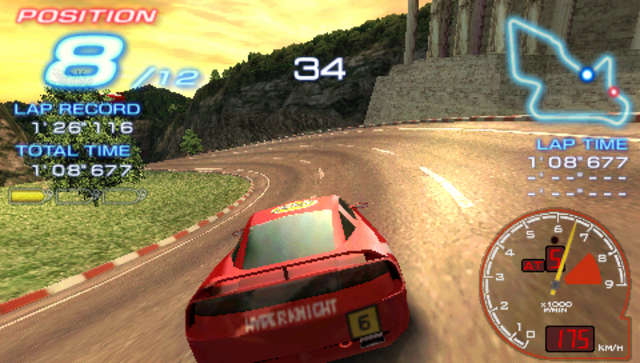
New-fangled high-definition Ridge Racer is very pretty
and all that, but
sometimes I miss the old candy-cane primary colours of
the original.
Ridge Racer 2
Probably the first
game that modern gamers would recognise as a racer of
the sort we play today, the original Ridge Racer
slightly predated Daytona USA and is also a far better
game. However, you can’t argue with a sequel that's
basically all the best bits from all the RR
games put together with better graphics, and that’s what
you get in the monstrously-inaccurately-named Ridge
Racer 2.
The only downside - shared with big-brother
titles RR6 and RR7 - is that it starts off terribly easy
where the original was challenging from the off, but
then with only one-and-a-half tracks the original HAD to
be. There’s such a crazy amount of content in RR2 that
it can afford to give a big chunk of it away cheaply at
the start to lure in the beginners and develop their
skills for the stiffer challenges ahead. With the
possible exception of Burnout 2 (see below), simply the
most complete road-racing game of the modern era.
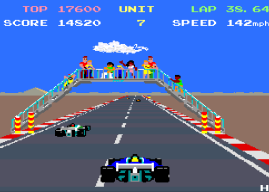
In the early days, Suzuka’s spectator facilities were
sparse.
Pole
Position 2
The first Pole
Position was a phenomenal success, and the sequel
actually did rather less well. However, it was a very
influential pioneer in a very specific field, namely the
inclusion of multiple real-life racetracks. PP1 had
dipped a toe into the water with a pretty authentic take
on the Fuji Speedway course in Japan – the first time a
real-world track had appeared in a videogame - but PP2
offered four selectable courses all based around
real-world race venues, adding recognisable versions of
Indianapolis (a simple oval), Long Beach and Suzuka.
Namco extended the
concept with their Final Lap series, which expanded the
roster with interpretations of Silverstone, Catalunya,
Spa Francorchamps and Monaco, and it’s almost as hard to
imagine an F1 game set in fictitious locations now as it
is to imagine one with only one track.
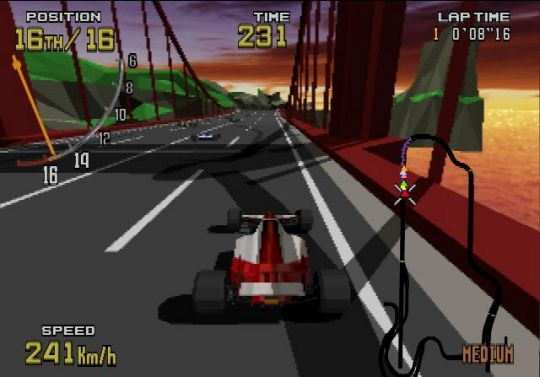
This is a shot of the rather lovely PS2 remake Virtua
Racing Flat Out, which
is well worth picking up on the excellent-value Sega
Classics Collection.
Virtua Racing
Virtua Racing is a
wonderful game, but it’s historically important for
mostly a strange and unfortunate reason. VR offered four
switchable camera positions, the best of which was the
high overhead cam which gives the driver the clearest
possible view of his racing line. But the most popular
was the first-person perspective, something which had
been rare in driving games until that point, and the
high overhead cam was immediately binned for all Sega’s
subsequent arcade racers, perhaps also because of the
extra processing demands it would make when rendering
their more complex, textured scenery.
The side-effect of
that was to destroy, almost overnight, the credibility
of the entire overhead-view racing genre - which till
then had maintained significant success with games like
Super Sprint, Hot Rod, Super Off-Road and Micro Machines
- and focus future driving-game development entirely on
the first-person view. It’s not much of a legacy for
such a great game, but history can be cruel.
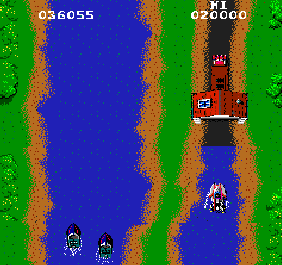
Spy Hunter: also the pioneer in the classic ‘Drive a
motorboat into the
back of a truck parked in a shed and turn it into a
sports coupe’ genre.
Spy
Hunter
Bally’s 1983 classic
Spy Hunter isn’t strictly the first racing game in which
you can directly attack your opponents with weaponry –
you could argue, for example, that Namco’s 1980 Rally-X
claims that accolade with its smoke-screens, or that
Bump’n’Jump from Data East two years later deserves it
by enabling you to actually destroy opponents. But in
the sense we understand the genre today, Spy Hunter is
the crucial first ancestor of games like Mario Kart and
Wipeout, where shooting or otherwise interfering with
your opponents is at least as important as overtaking
them. It was remade in 2001, with modest results.
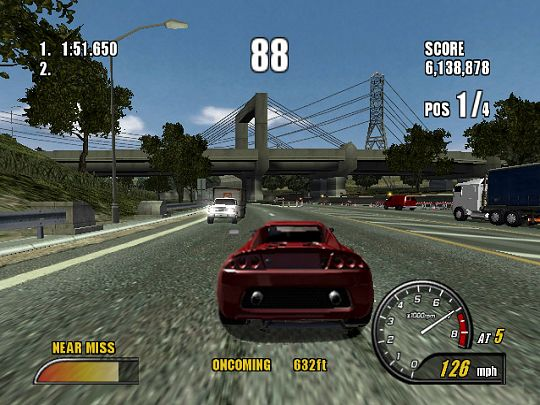
One of the best games, in any genre, of its generation.
Sadly, it was all downhill from here for Burnout.
Burnout 2
Now derived from the
1984 ram-racing template of Bump’n’Jump, The Burnout
series is an excellent example of why someone invented
the phrase “If it ain’t broke, don’t fix it”. A
franchise which started with a menacingly serious game
of almost Spartan minimalism and toughness is now little
more than a bloated, devalued insult to the intelligence
of 11-year-olds, offering up spectacular pyrotechnics
and breathless cascades of medals and trophies to anyone
who can hold down a fire button.
But the second game in
the series is a masterpiece, combining white-knuckle
racing tension with the brilliantly cathartic interludes
of the Crash Junctions. Subsequent iterations would
screw up both elements of this simple genius horribly,
but Burnout 2 strikes a perfect balance between
challenge and reward whether you’re racing or crashing.
|
|
TO READ THE REST OF THIS FEATURE
(6,980 words), BECOME A
WoS SUBSCRIBER |
|

